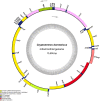Characterization of the complete mitochondrial genome of Cryptotermes domesticus (Blattodea: Kalotermitidae): Genome description and phylogenetic implications
- PMID: 36205070
- PMCID: PMC10078508
- DOI: 10.1002/arch.21974
Characterization of the complete mitochondrial genome of Cryptotermes domesticus (Blattodea: Kalotermitidae): Genome description and phylogenetic implications
Abstract
The complete mitochondrial genome of Cryptotermes domesticus (Haviland) was sequenced and annotated to study its characteristics and the phylogenetic relationship of C. domesticus to other termite species. The mitogenome of C. domesticus is a circular, close, and double-stranded molecule with a length of 15,655 bp. The sequenced mitogenome contains 37 typical genes, which are highly conserved in gene size, organization, and codon usage. Transfer RNA genes (tRNAs) also have typical secondary structures. All of the 13 protein-coding genes (PCGs) start with an ATN codon, except for nad4, which starts with GTG and terminates with the terminal codon TAA and TAG or the incomplete form T-- (cox2 and nad5). Most tRNAs have a typical cloverleaf structure, except for trnS1, in which this form is replaced by a simple loop and lacks the dihydrouridine (DHU) arm. The nucleotide diversity (Pi) and nonsynonymous (Ka)/synonymous (Ks) mutation rate ratios indicate that nad1, cox1, and cox3 are the most conserved genes, and that cox1 has the lowest rate of evolution. In addition, an 89 bp repeated sequence was found in the A + T-rich region. Phylogenetic analysis was performed using Bayesian inference (BI) and maximum likelihood (ML) methods based on 13 PCGs, and the monophyly of Kalotermitidae was supported.
Keywords: Cryptotermes; Kalotermitidae; mitochondrial genome; phylogenetic analysis.
© 2022 The Authors. Archives of Insect Biochemistry and Physiology published by Wiley Periodicals LLC.
Conflict of interest statement
The authors declare no conflicts of interest.
Figures





References
MeSH terms
Substances
Grants and funding
LinkOut - more resources
Full Text Sources
Research Materials
Miscellaneous

